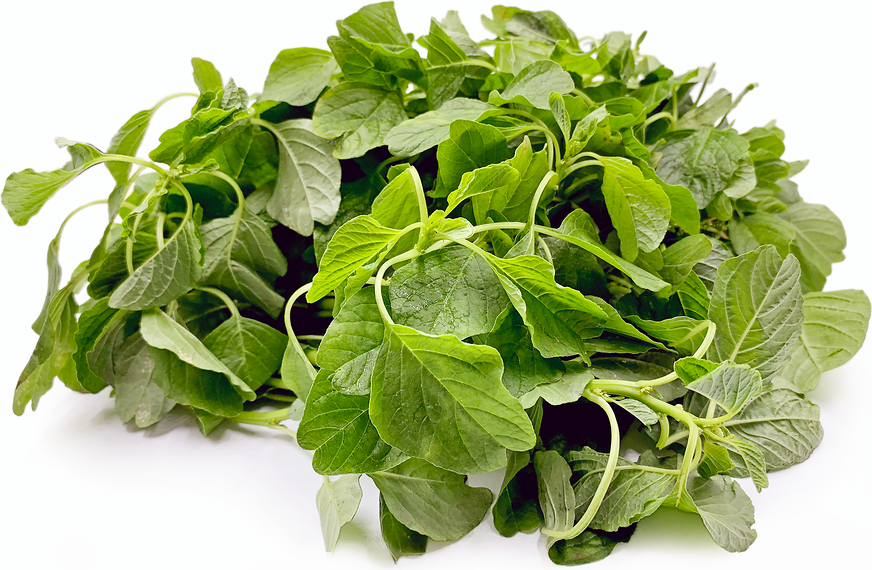


Indian Keerai Spinach
Estimated Inventory, lb : 0
Description/Taste
Indian Keerai spinach is small to medium in size and broad, flat, and oblong in shape. Depending on the specific variety, the leaves can be vibrant green, coarsely textured, slightly wrinkled, and contain a prominent center rib. Indian Keerai spinach leaves also have delicate and thin, crunchy, light green stems. Indian Keerai spinach leaves are slightly astringent when raw, but when cooked, they become tender, sweet, slightly nutty, and a little tangy.
Seasons/Availability
Indian Keerai spinach is available year-round.
Current Facts
Indian Keerai spinach leaves, botanically classified as Amaranthus, grow on a perennial plant and are members of the Amaranthaceae family. Amaranth is a general term that includes more than sixty different species. Indian Keerai spinach is a term to classify Amaranth leaves in many Southeast Asian countries, and there are around six commonly used Amaranth varieties in Asia that are generally referred to as Keerai and Bayam. In addition to these terms, the Tamil word for greens is "keerai" and can be used to describe various greens from spinach to mustard greens. "Mulai Keerai" is used to describe amaranth at its early stages with the youngest and most tender leaves. "Arai Keerai" describes the amaranth leaves in its middles stages of growth and "Thandu Keerai" is the amaranth leaves at its most mature stage. These descriptors are often used in Indian recipes to distinguish the maturity of the leaves to get the appropriate flavor for the dish.
Nutritional Value
Indian Keerai spinach leaves are high in vitamin C, vitamin A, calcium, potassium, and folate. They also contain iron, magnesium, and phosphorus.
Applications
Indian Keerai spinach leaves can be used in both raw or cooked applications such as stir-frying, steaming, sautéing, and boiling. They can be added to salads and are commonly used in soups, stir-fries, rice dishes, dals, and curries. Indian Keerai spinach leaves can also be stuffed into phyllo pastries or sautéed and mixed into pasta dishes. Complimentary flavors include bacon, ham, poultry, anchovies, garlic, onion, sesame seeds, soy sauce, lemon, mushrooms, oregano, dill, cumin, goat cheese, parmesan, ricotta, mustard, and walnuts. Indian Keerai spinach leaves will keep up to one week when stored in a plastic bag in the refrigerator.
Ethnic/Cultural Info
In Asia, the Indian Keerai spinach is widely grown and cooked as a daily vegetable dish. In Indonesia, over 20,000 hectares are planted each year, and the leaves are fast-cooking and are often lightly stir-fried in oil. They are also dipped in a batter of diluted rice flour spiced with coriander, garlic, and salt, and then fried until crisp. These are known as "crackers," and are a popular snack in Indonesia. In India, Indian Keerai spinach leaves are fried in cutlets and rice dishes, but it's most popularly cooked into dals, curries, and Masiyal, which is a mashed spinach dish. In China, the leaves and stems can be used in clear soups with other ingredients like wolfberries or sautéed with eggs. In addition to culinary uses, Indian Keerai spinach leaves are traditionally believed to help reduce symptoms of coughs and bronchitis.
Geography/History
The exact origins of Indian Keerai spinach are relatively unknown, but amaranth, in general, is native to Mexico, Peru, and Argentina and has been cultivated for over 8,000 years. The seeds were then spread around the world via explorers and traders and became prevalent in Africa, Nepal, and India. Today Indian Keerai spinach can be found at specialty markets in India, the Philippines, Vietnam, Malaysia, Indonesia, China, Africa, South and Central America, the United States, and Greece.
Recipe Ideas
Recipes that include Indian Keerai Spinach. One
| 7aum Suvai |
|
Thandu Keerai Kootu |
| Yummy Tummy |
|
Keerai Sambar |














